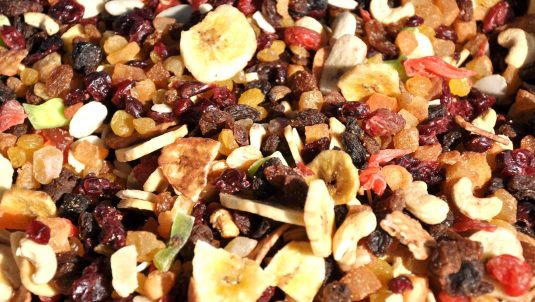Dried fruits have been around for centuries and were first very popular in the Mediterranean and Middle Eastern areas of the world and are even sometimes referred to as Mediterranean fruit.
Dates are one of the earliest dried fruits that became popular after a process of taking the water out of the fruit was discovered in the Mediterranean thousands of years ago by drying fruit in the sun. Today, we can purchase dried fruit that has already been dried for us or dry out our own fruit in a piece of equipment called a dehydrator.
When the water is removed from the fruit, it significantly increases the sugar content that is in the fruit and makes it very concentrated. This means people with diseases, such as diabetes, should probably not consume dried fruit, but for the rest of us, it can be a very healthy snack.
Most popular dried fruits that people enjoy eating are raisins, prunes which are also referred to as dried plums, apricots, peaches, bananas, mangos, pineapples, and several different kinds of berries.
Is Dried Fruit Healthy?
Dried fruit is a great option for a snack since it is highly nutritious and loaded with fiber, antioxidants, and micronutrients. Just one piece of dried fruit contains about the same amount of nutrients as the fresh fruit does. It is condensed in a much smaller package and easier to eat, especially when you’re on the go.
For example, when you compare a piece of fresh fruit with its dried fruit equivalent, by weight the dried fruit contains nearly four times the amount of fiber, minerals, and vitamins than the fresh fruit. This means that one serving of dried fruit can provide your body with a large portion of the daily recommended amount of minerals and vitamins, such as folate and vitamin D.
One downfall when it comes to dried fruit is that there are some vitamins that are actually decreased in the drying process of the fruit, including vitamin C. On the upside, dried fruit contains a ton of fiber which is a wonderful source of antioxidants that your body needs, including polyphenol antioxidants, which have been linked to a variety of health benefits, including improved digestive health, better blood flow, last oxidative damage to the body, and the reduced risk of a variety of diseases.
Benefits of dried fruits
There are many benefits of dried fruits, from being able to eat them on the go, using them in other recipes, and the fact that dried fruit is full of health benefits. Multiple studies have been done over the years by various groups and scientists who have discovered that people who eat dried fruit tend to weigh less than others and seem to consume more nutrients than other people who do not eat dried fruit.
Dried fruit is also a wonderful source of a variety of plant compounds, including the various vitamins, minerals, and antioxidants that we have already discussed in this article. Dried peaches, as well as apricots, are great sources for your body when it comes to carotenoids, which your body uses to turn into vitamin A. Dried prunes, raisins, and apricots contain a high level of iron which the body also needs. Fiber is also important to the body, including your gut health, and dried fruit has plenty of it.
For example, there are 2.5 grams of fiber in a small number of raisins and 2.9 grams in a hand full of dried apricots.
It is important to note that while dried fruit has an array of benefits for the health of your body, you need to be extra cautious when you eat it since pieces can stick to your teeth which, over time, can cause dental decay or other tooth and gum issues. It is less likely to stick to your teeth if you eat it as part of a meal and not by itself.
Where can I add dry fruits to my meals?
There are a variety of meals that dried fruit can be added to. For example, raisins are used in literally thousands of recipes, from oatmeal cookies to salads and breakfast foods. You can make a homemade trail mix that contains raisins along with nuts and cereal as well as other dried fruits. You can whip up recipes such as baked apples that are topped with raisins and walnuts or add them as a topping to your cereal or oatmeal. You can also top cereal with dried apricots or layer it on top of a yogurt parfait. You can add dried apricots to soups and stews as well as dishes such as rice pilaf.
Dried prunes can be used in stir-fries, added to chicken dishes, or even used to replace part of the fat content when you are baking a variety of different desserts. Dried figs can be used to top off fresh fruit also in stir-fries or even as part of a paired dish that is topped with blue cheese or feta cheese. The possibilities are endless when using dry fruit in recipes.
What dried fruits should you avoid?
There are certain dried fruits that you should avoid, or at least avoid eating too many of them or eating them too often. For example, when it comes to dates, almonds, cashews, walnuts, and pistachios, you should avoid eating too many at once because they can cause excessive body heat to occur, which can lead to a breakout of rashes and unsightly pimples. Yes, taking almonds, dates, cashews, pistachios, and walnuts in excess amounts can lead to excessive body heat, giving rise to nasty pimples and rashes.
Since fruit contains glucose and fructose and those levels are much more concentrated in fruit that has been dried through a process of dehydration, you should avoid all dried fruits if you are doing a low-carb or Keto diet and especially if you suffer from diabetes since it can definitely increase the insulin level in your body.
Overall, dried fruit is a great option when you are on the go and want to eat something that is quick and easy while still getting the many benefits that these organic snacks can give you. If you enjoy organic eating, Organic Restaurants has everything you need to seek out the best organic restaurants around. You can even enjoy a variety of dishes that include an array of dried fruits that are delicious and healthy.
Find restaurants with organic options near you
Search by city or see restaurants close to you.



 Sign in with Google
Sign in with Google Sign in with Facebook
Sign in with Facebook